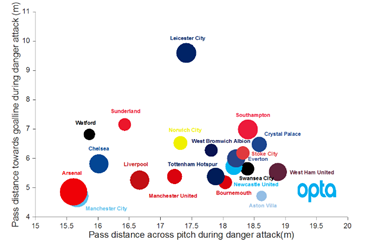
An article 3 years in the making; Jack Coles follows up on one of the best articles of 2013 with a detailed report about how the relationship between Data Analytics and football has progressed.
Editor’s Note: This article will be published in 3 separate posts. The 2013 article can be found here. The first post of this part can be found here, and the second here.

Because of the threat of the competition, much data analysis remains unseen and undisclosed in the football industry. But data analytics’ best story may not be very thinly veiled after all. If Gabriel Marcotti is correct in his informal study about managers who apply their data analytics teams work in the Premier League, then Claudio Ranieri (or his predecessor, Nigel Pearson) has (or had) to be one of those two men. How else does a man fired from the Greek national team for losing 0-1 at home to the Faroe Islands in the UEFA Euro 2016 qualifying win the Premier League with a team who Stefan Szymanski (co-author of Soccernomics) estimated, ‘the wage budget for Leicester in the current season [2015-2016] would have ranked them about 12th in the Premier League’?
To what level did Ranieri use information from the data analytics team at Leicester? At the very least, ceding some control to Leicester’s staff over tactical systems, and at the most being simply a well-liked figurehead and spokesperson for the side during their remarkable year. There is a strong amount of evidence that the 2015-2016 title victory for Leicester City owes a huge amount of credit to their data analysis team, and as yet this has been largely unmentioned. The term Moneyball is on the tip of our tongues. So many things went right for Leicester in the 2015-2016 season, but their striking tactical set-up really illustrated that their departure from conventional football could have been led by data analytics.
Leicester City appear at the more extreme end of many simple tables on whoscored.com for the 2015/2016 season. For instance, they have the third lowest average possession in the league, the second lowest average pass success rate, the joint highest amount of counter attacking goals (five), the third lowest amount of short passes, and so on. In these rudimentary lists, Leicester City are surrounded by teams at the lower end of the table, the likes of Sunderland A.F.C and West Bromwich Albion. As they had very different seasons to their bedfellows, it suggests design, rather than accident.
Such a surface analysis of their style of play provides only a suggestion that Leicester City owe enormous credit to their data analysis team for their ridiculous title victory, given the extremes. Leicester City can lay a claim to be the team most successful team in England at implementing data analysis into their club. Not quite as far along as FC Midtjylland, but perhaps the English equivalent.
If we look further at Leicester’s on-field activities we see, (click here to view) with credit to Twitter’s @11tegen11 (at 11tegen11.net – a fan of the ExG), the verticality of the side, with almost no interaction between the back four at all, as shown in four separate Premier League encounters by @11tegen11’s graphics. Contrast is offered by looking at a side like Everton F.C. (with average, more common interaction between the back four) and Barcelona (with loads). It’s a pretty unique system, and avoids Guardiola’s dreaded U-shape, and the idea the Catalan manager instilled on Europe that control of possession equates success, that many larger teams are shifting toward. Even our friends Atlético Madrid moved towards control of possession at the beginning of the season 2015/2016 La Liga (then Simeone thought better of it – and they really improved)
David Sumpter, who made his debut as an author recently with ‘Soccermatics: Mathematical Adventures in the Beautiful Game’, says: ‘it is this combination of well-defined roles and direct counter-attacking that makes Leicester so effective. Shown below are the pass distances up and across the pitch during the 30 seconds leading up to a dangerous shot during for all Premier League teams this season. The size of each circle is proportional to the number of chances created.’ This is reference to the below graphic. Proof, if it were needed, of Leicester’s unique tactics. They are really on their own here.

Image courtesy of David Sumpter (@Soccermatics). Made using Opta Data.
This style of play, a feature of their season, is more than likely as a result of some form of data analysis. We can see Leicester City move the ball very quickly, and very directly up to their forward players, preferably in a counter-attack, with little care of need for possession. Indeed, whoscored.com shows they are fifth in most long balls played in the 2015-2016 season. Sumpter continues: ‘Leicester don’t make the longest passes in the Premier League … but their passes take the ball nearly 3m further up the pitch than any other team. The ball moves rapidly from their defensive territory to their attacking territory’.
How much of this simple summary of their style of play was borne in the data analysis department? Sky sports gave credit to Leicester City’s team of analysts as one of their ‘Five unsung heroes in Leicester’s Premier League title challenge’ in a Buzzfeed-inspired post on their website. With insight in stark contrast with the click-bait title, and the bulk of the piece, Sky Sports state: ‘Blake and Clark, alongside tactical analyst Adam Sadler, are… in position at the King Power Stadium, providing the very best analysis of opponents, tactical feedback, post-match analysis and stats. Analysis at Leicester is not just constricted to a match day either, with technical scout Ollie Waldron providing analytical insights into the performances of prospective transfer targets.’
As Sky Sports suggest, Leicester City’s data analytics will extend further than just on-field actions, as clearly their player recruitment has been great too, for a club of their size. So much so, that the aforementioned departure of Ben Wigglesworth and the expected departure of Steven Walsh at the time of writing this, both to Arsenal F.C, shows their analytics and scouting staff are in demand. The Blake and Clark mentioned by Sky Sports are Andy Blake, who is the Head of Performance Analysis, and Peter Clark, who is one of Andy’s Performance Analysts, and they remain at the club.
Roger Bennett seems to agree that Leicester’s insight and data analytics helped them win the Premier League, particularly in regards to player recruitment. Roger Bennett, a journalist with an American podcast called Men in Blazers, focusing on the English Premier League for American audiences, spoke on the Freakonomics podcast covering Leicester’s famous title win. He stated: ‘[Leicester] have scouted unbelievably well. They realised they didn’t have the money. They were willing to look at certain statistics in a slight Moneyball variation that the big teams just didn’t value.’ Moneyball – there’s that word again.
Other questions with Leicester go unanswered, like how did they keep more-or-less their entire team fit throughout the whole campaign? Admittedly not a first, but it’s proving harder and harder, although they didn’t have Europe to contend with.
Devin Pleuler, aforementioned, gave huge credence to the fact that Leicester owe a lot to their analytics staff. He tweeted on the day they won the league: ‘Huge congrats to the folks over at @LCFC_Analysis. Unfathomable achievement. Your team will be studied more closely than any in history.’
Who knows? Maybe one day Leicester will tell us how they did it.
An article from the Opta Pro blog on Leicester in 2015 stated: ‘Leicester aren’t the only club to implement data-led analysis, but they are an excellent case study of what a progressive, forward-thinking club will look like. Through their cross-departmental relationships, a willingness to embrace new styles of working and constant evaluation process, data analysis is certainly part of the furniture here at the King Power.’ It’s hard not to agree.
In this article Peter Clark also states: ‘The coaches, along with the players, are our primary audiences, so sharing an office with them makes a huge difference. It means with just the turn of a shoulder we can discuss ideas and talk things through. And it’s the same with the recruitment team.’
It’s small things like this that could set Leicester City apart. Although they may never have a season like the 2015-2016 season, they look set to continually maximise their on-field output through clever data analytics, with a good club culture to promote this.
What is likely is that the use of data analysis will continue to rise over the next 12 months and beyond, both in popularity, application and reputation. It’s possible in the absence of a transformative metric – like on-base percentage – a few clubs will benefit in the short term, and then best practice will spread through the movement of information and staff around the league. But the rise of data analytics in football is certainly more advanced than the last review in 2013.
So what to keep an eye on? One section of football analytics left undiscussed is the contribution from bloggers (sporadically mentioned throughout), all with popular twitter accounts, who are constantly working on metrics and presenting their statistics to help their followers (both in the Twitter sense of the word, and the fan sense of the word) to understand football better. De Hoog’s article on Midtjylland was edited to include a citation: ‘The blogger Sander IJtsma uses this similar model’, (11tegen11.net), when referring to the Danish clubs methods of comparing teams around Europe.
And where else could data analysis go? Potential corruption has been uncovered in the Italian Serie B using data analysis, admittedly and understandably (but unfortunately) was not from within the sport. This may inspire a more potent defence against match-fixing, but this progress was unthinkable without accessible data and the increased computer power of the 21st century. It’s also hopeful that this varied use of data analysis can help improve transparency within the sport, particularly at a time when public trust in FIFA is non-existent. Player’s agents are often seen as corrupt themselves, perhaps unfairly, but also are more and more relying on rudimentary statistics and metric to alert clubs to their player’s ability.
Things aren’t perfectly on course however. Data analysis in football still has a heavy weighting towards on-the-ball actions. This is a mistake, since on-the-ball actions are such a small percentage of the game (but do have the biggest impact on the result, admittedly). Squawka, and the better known Opta, both commit this crime. If a metric could be developed in the future to measure off-the-ball actions, surely more telling, then maybe we will have a better understanding of the game, and a less predictable Ballon d’Or.
Blake Wooster informs us: ‘there’s some amazing research that’s coming out of Sweden at the moment in terms of being able to measure game intelligence and executive functions… and I think that’s going to change the game’, which seems a welcome, promising start to off-the-ball analysis.
Whatever happens, we’ll talk in another three years.
Written by Jack Coles






















































